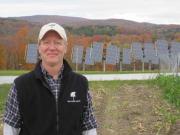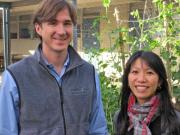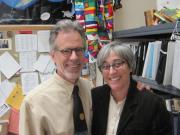Higher Education Goes Green: Yale and Pomona
My research on K-12 green schools has convinced me that we need to forge stronger ties with the university sustainability community. Here are two examples from the college and university world that illustrate the significant strides that are being taken. And it is for the world of higher education, after all, that we are preparing our students.
1. Sustainable Yale: Leadership for a Greener Globe
While reading my alumni magazine one day in 2005, I came upon a remarkable article about Yale going green. Declaring that climate change was one of the most pressing issues facing society today, President Rick Levin had committed Yale to a greenhouse gas reduction goal of 43% by 2020. The accompanying bar graph showed that the university’s carbon footprint was the size of a small Caribbean nation. The clarity of the challenge, and of the university’s response, was inspiring. It led me to adopt a similar vision at Head-Royce School in Oakland, California where I was the Head of School. Visiting New Haven on a brisk October day, and conversations with Eugenie Gentry, Associate Vice President for Development, and Melissa Goodall, Assistant Director of the Office of Sustainability, gave me a chance to understand firsthand Yale’s significant leadership in making the university, and the globe, a more sustainable place.
Yale’s commitment to environmental sustainability spans more than a century. In 1900 the university established the first forestry school in the nation, headed by alumnus Gifford Pinchot. Among its first graduates was Aldo Leopold, a pioneering environmentalist whose Sand County Almanac is a classic in the field. Over the years the school grew, changed its name to the School of Forestry and Environmental Studies, and took on a central role in greening the university, and in developing leaders to address the complex, critical global environmental challenge we face. I have felt a personal connection to FES and its work through its impressive graduates, like my fellow Yale alum Frances Beineke, who heads the Natural Resources Defense Council, and my Stanford colleague professor Nicole Ardoin, who is leading a major study of environmental education in Northern California.
Fifteen years ago, Yale began to make environmental sustainability one of the university’s top priorities. In the late 1990s, undergraduates developed the Yale Green Plan, sparking the creation of the Advisory Committee on Environmental Management in 2001 and the first formal recommendations for institutional change. In 2004 President Rick Levin hired Julie Newman as the first Director of Sustainability, and the next year she opened a new Office of Sustainability. Newman has worked in the field of sustainable development and campus sustainability for two decades and came to Yale from having established the “longest-standing sustainability office in the country” at the University of New Hampshire. A Peace Corps volunteer in Guatemala, she received a BS in Natural Resource Policy and Management from the University of Michigan, an MS in Environmental Policy and Biology from Tufts University, and a PhD in Natural Resources and Environmental Studies from the University of New Hampshire.
With the Office of Sustainability beginning to emerge, the university presented its Sustainability Vision. “Yale University is committed,” they declared, “to integrated policies and systems that balance ecosystem vitality with human health and economic viability. The University engages its campus as a classroom and laboratory, encouraging coursework and research that result in practical sustainability applications that can be replicated and shared. Through these practices and philosophies, Yale aims to demonstrate that both Yale and World Sustainability are feasible and affordable.” That vision has led to a clear mission and charge to: “advance sustainability by fostering innovation, helping to streamline operations, and preparing tomorrow's sustainability leaders” and to “position Yale as a national and international model and leader in institutional sustainability - through education, outreach, research, and partnership.” To ensure that the Yale green effort is sustained, President Levin and his team prepared the university’s Sustainability Strategic Plan 2010-2013 and they report progress annually in the Greenhouse Gas Reduction Strategy.
Implementing the university’s vision and mission, the Office of Sustainability is focused locally and globally. It works closely with departments in charge of the university’s day-to-day operations, from improving energy efficiency, waste management, and green procurement, while also supporting the effort to effect global environmental sustainability polity. The Office of Sustainability has adopted five “organizing principles” to guide its work: Policy and Governance; Systems and Operations; Campus Engagement; Academic Integration; and Strategic Partnerships. This effort strives to maintain “an integrated, comprehensive approach to policy and operations that balances ecosystem health with human health and economic viability.” The Office encourages Yale’s decision-makers to incorporate sustainability into their vision, facilitates the “integration of economic, environmental, and social priorities…to strike a balance with the natural world and the community,” promotes campus engagement activities among all constituents, supports the integration of the principles and study of sustainability into the academic life of the university “using the campus as a living laboratory,” and forges strategic partnerships from the local to the global level to develop and share best practices.
To implement these ambitious plans, Yale has launched a wide variety of sustainability initiatives. To achieve the 2020 greenhouse gas reduction goal, the university established a policy to require a LEED Gold minimum standard for new construction and large renovations; the campus today boasts 14 LEED certified buildings, and they have undertaken significant retrofitting of building. With its Sustainable Food Project Yale runs an organic farm on campus with inspiration and encouragement from Berkeley’s Chez Panisse restaurant founder Alice Waters, and Yale Dining has become a leader in providing delicious, healthy food with an eye toward sustainable sourcing and production. To meet the energy needs of over 23,000 people and over 400 buildings, Yale owns and operates two power plants, including a co-generation facility and an extensive geo-thermal installation. The Office of Transportation Options works to reduce single-occupancy commuter trips, offers a bike share program, Zipcars, ridesharing and even “commuter counseling.” The university seeks to reduce waste through reduction, recycling, and repurposing, acknowledging that annually it generates about 4000 tons, about the same as a fully loaded garbage truck every day. Combined efforts have reduced Yale’s solid waste stream by 25% in recent years. An Environmentally Preferable Purchasing policy makes Yale more sustainable and “reaches beyond the university to begin greening the supply chain.” The Athletic Department has launched Bulldog Sustainability, and workout devices in the gym enable Yale community members to recharge a variety of electronic devices while recharging their bodies. Yale is also home to an extraordinary array of multidisciplinary research centers. Some, such as the Urban Resources Initiative, work with the city and public schools on local programs; others, such as the Center for Business and the Environment and the Center for Environmental Law and Policy work at critical junctions between disciplines; and still others, such as the Yale Climate and Energy Institute, act as on-campus facilities for dialogues at all scales.
In 2001 Melissa Goodall came to New Haven from work in Argentina, eventually joining the university as the Associate Director of the Yale Center for Environmental Law and Policy, and in 2009 she became Assistant Director of the Office of Sustainability to help lead the rapidly growing green initiative. “Yale is striving to become an exemplary global citizen,” she told me when I visited with her, and it clear she has had a long history of engagement with the environment. Raised in New Haven, she loved her visiting her grandparents in Ohio, where the “creek we played in became a living laboratory.” After getting a degree in acting from NYU, she realized she wanted to devote her career to sustainability, earning an MS from Antioch University New England in Resource Management and Administration, and now she is working on her PhD in Environmental Studies with research focused on approaches to governing the global commons that might transcend today’s model of international negotiations and begin to directly involve other stakeholders – including universities. She is seeking to understand and to promote how to build “an inclusive campus sustainability culture.” Our job, she said, is to “measure, message, and motivate.” A commitment to making global issues personal and actionable inspires her work at Yale. There are more than 50 graduate and undergraduate students working for the Office of Sustainability during the academic year, many of whom were working in small groups during my visit, to implement the Office of Sustainability’s agenda. In addition, the Sustainability Service Corps selects two students in each of the university’s twelve residential colleges to implement change. In her free time, Melissa Goodall is active in her community. In 2009, she established a volunteer-run farmers’ market in her neighborhood and for four years she was the captain of her block’s Greenspace Group, which planted 25 trees and hundreds of plants on one city block thanks to funding from Yale’s Urban Resources Initiative. These activities help her connect her global sustainability interests to the immediate community.
I had a chance to visit Kroon Hall, Yale’s new home for the Forestry and Environmental Studies School, a LEED Platinum building that exemplifies the sustainability ideals of the university. My guide was Eugenie Gentry, Associate Vice President for Development, who led the $43 million dollar campaign to support the construction of the 50,000 square foot building in 2009. Herself a graduate of Swarthmore, where she worked as intern over three summers for the Natural Resources Defense Council, she has devoted her career to financial services and philanthropy. As she explained, the new building incorporates many state-of-the-art features to promote energy efficiency and healthy operation, including an extensive rooftop solar array, 12” thick walls for better insulation, a geothermal heat pump system, a co-generation power system for heating and cooling, operable windows that can be opened when optimal conditions are signaled by a green light in the building, a rainwater catchment system that enables grey water to be used for toilets and irrigation and that reduces water demand by 75%, low VOC materials throughout the building, and the use of red oak paneling from the university’s woods in Connecticut. Kroon Hall is truly a magnificent testament to the power of the imagination to help us envision and realize a more sustainable future.
In September Sierra Club Magazine ranked Yale number eight in the nation among all colleges and universities based on a survey developed with the Association for the Advancement of Sustainability in Higher Education and the Princeton Review. As Yale observes, higher education is “arguably the most important and dynamic sector in society to lead the way on institutionalizing sustainability.” Though its leadership, Yale is providing the vision and the practical implementation strategies that point the way for all institutions, including K-12 schools, to become more environmentally sustainable.
2. Pomona College: A Green Oasis
When attending the Country Day School Headmasters’ Association annual meeting in June, I was reminded that Pomona is situated in an arid ecosystem east of Los Angeles, and the college’s significant commitment to environmental sustainability is even more remarkable because of the challenges that its location presents. The college’s leadership in the higher education field became apparent when it was named just one of seven out of more than 300 colleges and universities to receive a grade of A in a 2011 nation-wide survey by Sustainable Endowments Institute in their College Sustainability Report Card; they were in good company with Brown, Dickinson, Oberlin, University of Minnesota, University of Wisconsin, and Yale. Meeting with Seth Allen, Vice President for Admissions and Financial Aid, gave me insight into Pomona’s commitment to environmental sustainability, a “matter that is of huge interest to our students,” he noted. My several days at the college enabled me to understand that the recognition the college has received for environmental leadership was richly deserved.
Pomona’s strong vision, clear mission, and outstanding organization for sustainability were evident throughout my stay at the college. The college has increased its use of drought-resistant plants in landscaping; features a Green Bikes Program run by students that offers free bikes, maintenance and repair services to encourage bike usage; and is dotted with a number of new LEED-certified buildings: two Platinum, two Gold, one Silver. The new construction and renovations feature high-efficiency lighting, low E windows, low-flow faucets and toilets, solar panels for renewable power, roof top gardens, and a bioswale to improve water conservation. Over a decade ago students began to develop a six-acre piece of land on the eastern side of the campus that today is filled with many small plots of vegetables. The Dining Services purchases food from local growers, hormone and antibiotic free milk, and seafood that meets sustainability guidelines. The college has recently purchased a 50-acre ranch 10 miles away that will become the site of a new outdoor education program. Perhaps most telling, the college offers a degree in Environmental Analysis that is the third most popular and fastest rising major. The story of how Pomona developed a sustainability culture is truly instructive.
A decade ago Pomona began to develop its sustainability initiative when the Board of Trustees adopted the college's first Environmental Policy as recommended by the Environmental Policy Task Force. In 2003 of the college’s new president, research chemist David Oxtoby, arrived and brought a passion about the importance of environmental sustainability. That year the Board of Trustees went on to adopt a Statement of Environmental Policy, updated in 2009, that declared: “Pomona College recognizes that the local and global environment in which it operates must be protected for future generations. It is therefore committed to the further development of an ethos of resource sustainability among faculty, staff, and students and to the incorporation of environmentally sound practices in its operations. Such commitments are essential if future generations are to have a healthy and productive environment.” The college also developed a set of core values to guide the sustainability initiative that was unfolding, including an accent on education. “Leading the way with teaching sustainability and practicing sustainable lifestyles” and “providing both a thorough classroom education on sustainability and environmental issues and spreading information and best practices related to sustainability technologies, ideas, and behavior” were top priorities. With a commitment to conservation, solutions-based progress, a long-term perspective, stewardship, community participation, economic responsibility and social justice, the college outlined an ambitious program. Significant developments quickly followed when the Board of Trustees adopted a Sustainable Building Guide requiring that all new construction or major renovations be LEED Silver Certified or the equivalent, a powerful leadership statement in the early years of the green building movement. In 2004 the Seaver Biology Building became the first green building on campus. And in 2006 two students started a chapter of Campus Climate Challenge and completed Pomona’s first carbon emissions inventory.
In 2007 Pomona’s effort to become a model green college moved into high gear. President Oxtoby established an Advisory Committee on Sustainability (PACS) to oversee sustainability efforts for the Pomona, signed the Presidents Climate Commitment, and declared that the college would soon create a formal emissions audit and a climate action plan. Implementing the committee’s recommendations, he arranged for a campus sustainability audit, which is broader than an emissions audit, and hired a new, full-time Sustainability Coordinator, Bowen Patterson, a young Pomona alumnus. In 2008-09, the Trustee Sustainability Task Force updated the Environmental Policy and Bowen Paterson launched Sustainability Action Fellowships for students to integrate their efforts fully in campus sustainability planning.
That year the Board launched a second, vital phase of the Sustainability Action Plan and created the Sustainability Integration Office. They established seven specific goals for the college, including reduced greenhouse gases; reduced resource impact; reduced air, water, and soil pollution and toxins; and increased environmental health for all members of the college community. Environmental awareness and education are paramount, they declared, and they will strive to ensure that “every student who graduates from Pomona has a greater environmental awareness than when they came.” Importantly, the college recognized that it would have to work to achieve “sustainable sustainability” and that “sustainability itself must be sustainable, meaning physical and organizational infrastructure must be in place to provide the support, resources, and motivation for sustainability efforts to continue” and that “financial (staffing and funding), procedural (policies and processes), or social (inclusion in public reports, speeches, and conversations about College priorities), resources and support are necessary for these efforts to continue.” In its last goal, a “public commitment to sustainability,” Pomona declared its intention to “be a leader in sustainability.”
The administration also outlined a detailed “Policy Implementation” plan focused on five key areas. For Campus Planning, Maintenance, and Construction, the college’s Green Building Standards mandated a minimum of LEED Gold certification for new construction, and declared that “all projects and project decisions will be assessed using life cycle cost-benefit analysis,” an essential tool that enables policy makers to focus on the long-term perspective. The college budget planning process is based on the sustainability values and focused on cost-savings. Curricular, extra-curricular, and research opportunities for sustainability-related education are to be funded. The President’s standing Advisory Committee on Sustainability monitors the implementation of the college’s policies, and it provides an annual report and recommendations for further initiatives.
As Pomona President David Oxtoby has observed, “Throughout the campus – among students, faculty, staff and trustees – there is strong commitment to making Pomona a leader of sustainable practices, and we are always looking for creative ways to be better stewards of our natural resources.” And notes Bowen Close, former director of Pomona’s Sustainability Integration Office, “Students have played a tremendous role in the creation and the success of our various sustainability programs and projects.” The Pomona experience demonstrates that when the leadership of a college develops a vision of environmental sustainability, and provides the resources to achieve it, the entire community is inspired to develop a model for how to green colleges across the country. With colleges like Pomona leading the way, the world of higher education is embracing vital changes that will transform their culture and shape the environmentally conscious leaders of the future.







